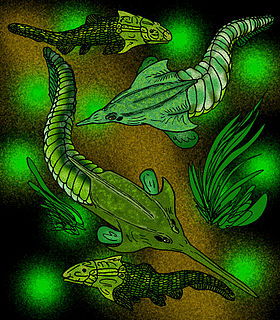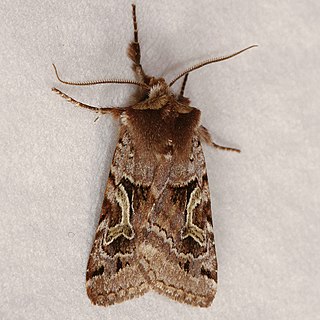
Unaysaurus is a genus of unaysaurid sauropodomorph herbivore dinosaur. Discovered in southern Brazil, in the geopark of Paleorrota, in 1998, and announced in a press conference on Thursday, December 3, 2004, it is one of the oldest dinosaurs known. It is closely related to plateosaurid dinosaurs found in Germany, which indicates that it was relatively easy for species to spread across the giant landmass of the time, the supercontinent of Pangaea.

The Pituriaspida are a small group of extinct armored jawless fishes with tremendous nose-like rostrums, which lived in the marine, deltaic environments of Middle Devonian Australia. They are known only by two species, Pituriaspis doylei and Neeyambaspis enigmatica found in a single sandstone location of the Georgina Basin, in Western Queensland, Australia.

Tarascosaurus is a genus of abelisaurid, theropod dinosaur from Late Cretaceous of France.
The Chiapas catfish, Lacantunia enigmatica, is an unusual species of catfish from the Usumacinta River basin in the Mexican state of Chiapas and in Guatemala. It was scientifically described in 2005 and placed in its own family Lacantuniidae. While discovery of an undescribed species of catfish is not uncommon, discovery of a new family of any vertebrate group is a rare event. The Chiapas catfish mainly feeds on crabs, prawns, small fish, and large, tough plant seeds. This catfish is commonly fished in its natural habitat, where it is known as madre de juil, which means "mother of Rhamdia".

Neeyambaspis enigmatica is the lesser known of the two species of pituriaspid agnathans. The species lived in estuaries during the Middle Devonian, in what is now the Georgina Basin of Western Queensland, Australia.
Austrorossia enigmatica is a species of bobtail squid native to the southeastern Atlantic Ocean; it occurs off the coast of southern Africa from Namibia to Cape Province. It lives at depths from 276 to 400 m.
Deepstaria enigmatica is a very rarely seen giant jellyfish of the family Ulmaridae first described in 1967 by F. S. Russell. The bell of this jellyfish is very thin and wide, and resembles a translucent, undulating sheet or lava lamp as the animal moves. They are usually found in Antarctic and near-Antarctic seas but have been spotted in waters near the United Kingdom, at depths of 600 to 1,750 meters.
The enigmatic scale is an unusual musical scale, with elements of both major and minor scales, as well as the whole-tone scale. It was originally published in a Milan journal as a musical challenge, with an invitation to harmonize it in some way.
The Bloom Township High School District 206 is a public high school district that serves Bloom Township, Illinois, United States. The district consists of 3,558 students in grades 9-12 in two high schools and one alternative high school.

Cyclemys is a genus of freshwater turtles, commonly referred to as Asian leaf turtles, from the family Geoemydidae. The genus occurs throughout Southeast and South Asia, and currently contains seven species.
Bukobaja is an extinct genus of mastodonsaurid temnospondyl from the middle Triassic of Russia. It contains a single species, Bukobaja enigmatica. Bukobaja mainly occurs in the Bukobay Svita as part of the Ladinian?-age "Mastodonsaurus fauna", a section of Russian Triassic biostratigraphy characterized by "Mastodonsaurus" torvus. It was also present in the underlying Donguz Svita. Bukobaja appears to be a valid genus similar to, yet distinct from, Mastodonsaurus. Despite appearing to possess several unique features, Bukobaja is still known from very few remains. This has led to difficulties in determining its relations more precisely than "Mastodonsauridae incertae sedis". It has also been compared to trematosaurids.

Cerastis is a genus of moths of the family Noctuidae.

Cyclemys enigmatica, tentatively dubbed as the enigmatic leaf turtle, is a species of Asian leaf turtle found in the Greater Sunda Islands.

Deepstaria is a genus of jellyfish known for their thin, sheet-like bodies. The genus is named after the Deep Star 4000, which collected the holotype of the type species, D. enigmatica.
Deepstaria reticulum, is a jellyfish of the family Ulmaridae. It was described by Larson, Madin, and Harbison in 1988. This was the second described Deepstaria species, the first having been Deepstaria enigmatica.

Dendrogramma enigmatica is a species of siphonophore, the only one in its genus. It has been first described in 2014 on the basis of its morphology from a collection of specimens gathered in 1986. Its taxonomic affinity among animals was then unclear, but RNA from new specimens in 2016 allowed it to be identified as a siphonophore by barcoding and phylogenomics. The specimens are presumed to represent parts (bracts) of an entire siphonophore that has not been identified yet.

Epanastasis is a moth genus in the family Autostichidae.
Brasilomma is a monotypic genus of Brazilian ground spiders containing the single species, Brasilomma enigmatica. It was first described by Antônio Domingos Brescovit in 2012, and is only found in Brazil.

Cerastis enigmatica, the enigmatic dart, is a species of cutworm or dart moth in the family Noctuidae. It is found in North America.

Transorchestia enigmatica is a species of beach hopper in the family Talitridae. So far, it has only been found in Lake Merritt in Oakland, California, where it was found by Jim Carlton in 1962. In 1967, Carlton and Edward L. Bousfield of the National Museum of Canada published a paper naming it Orchestia enigmatica. Bousfield re-classified it as Transorchestia enigmatica in 1982. It is not thought to be endemic to California. Its closest known relative is the Transorchestia chiliensis.











